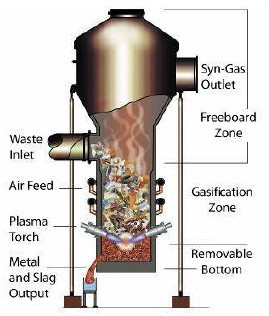
Plasma gasification is the emerging technology of a multi-stage process that converts carbon-based waste materials into fuels. Its feed input can range from Municipal Solid Waste (MSW) to plant matter and can also include hazardous waste.
A plasma torch is the basic source of plasma in the process. It creates controlled and constant lightening by passing electricity from the tip of one electrode to another. The air exposed to this lightening becomes highly energized and is ionized to form what is know a plasma, the fourth state of matter. The energy created is released in the form of heat at 10000˚C. The air is drawn from the plasma torch into a cupola that can retain and distribute it evenly. This creates a “zone of influence” which is hot enough to break the bonds of most molecules into simpler elemental structures. Metals that do not vaporize, melt and get captured in an inert glass form. In this process, MSW is converted into clean synthesis gas, or syngas. Syngas primarily consists of carbon monoxide and hydrogen gases. This fuel can be used to generated electricity. No incineration is required in this entire process.
At industrial scale, MSW is usually fed into a plasma gasifier containing four to six plasma torches and a bed of metallurgical coke and limestone is used in the copula to create a medium of evenly distributed, high heat. The syngas is thoroughly cleaned and cooled down before its used to generate electricity. The remnant inorganic components of the fuel, which do not vaporize, are converted into non-toxic slag that can used as construction material.
Plasma Gasifier (Source: Westinghouse Plasma)
BENEFITS OF PLASMA GASIFICATION
- As opposed to simple gasification using conventional fire and furnaces, plasma gasification provides a more intense source of heat which causes hazardous components to be completely destroyed.
- By converting solid waste into useful fuels, it monumentally slows down the build-up of landfills.
- It is a low-oxygen process, which produces fewer polluting oxides as compared to any alternative treatment method. It also does not generate methane.
- It has an extremely high waste to energy conversion rate.
Due to its high efficiency of converting carbon-based materials to clean syngas, and non-organics to slag, plasma gasification might as well be the technology of the future.







